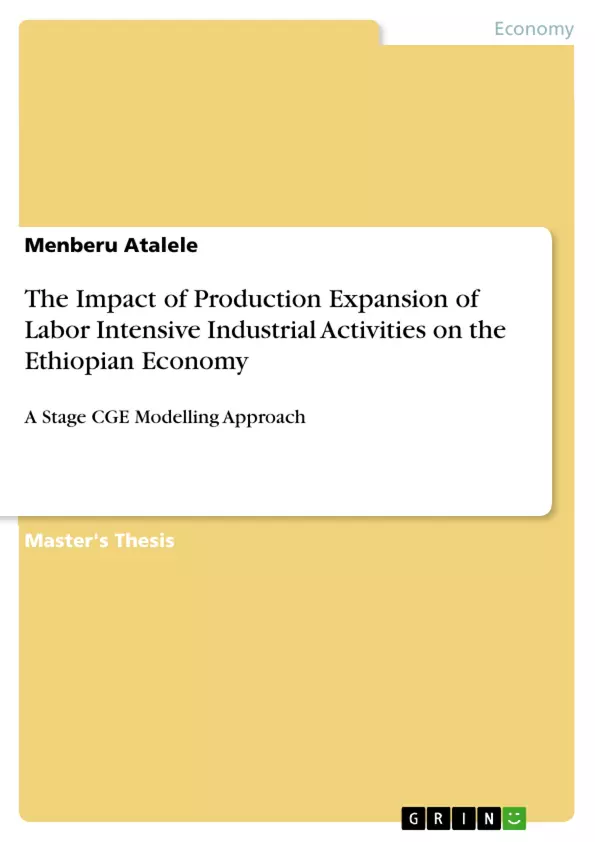Ethiopia’s industrial activity has been characterized by meager growth for the last epochs. But recently the Ethiopian government endorsed Growth and Transformation Plan (GTP) which gives prime attention to selected industries. This study examines the likely effect of productivity expansion of labor intensive industrial activities on the macro economy, government priority industries, factor and household income and welfare of households. The sectors were selected from the Ethiopian 2009/10 SAM based on their production characteristics. The selected labor intensive sectors include dairy, grain milling, milling service, sugar refining, other food process, beverage, textile, leather product and wood products. In order to investigate the impact of a 10% increase in the technical coefficients of these labor intensive industrial activities, the study used the static stage computable general equilibrium (CGE) model. The recently updated 2009/10 Ethiopian SAM was used to calibrate important parameters of the CGE models.
The 2009/10 Ethiopian SAM revealed that 45.22% and 52.13% of rural and urban households generate their income from labor. The production expansion via an increase in their technical coefficient of the sectors derived significant change on macro variables such as real GDP, government consumption demand, investment demand, household consumption, export and import of goods and services. The GDP of the economy has been increased by 3.41%. The findings also suggest that production and export increase in government prioritized industrial products largely .For instance, the production of the textile and leather sectors increased by 26.08% and 41.03%,respectively.Increasing the production of labor intensive industrial activities showed significant decline of import of priority industrial goods. It also resulted in welfare gain to all rural and urban households. The study further extends its recommendation for Ethiopia to develop a strong industrial policy aimed towards promoting labor intensive industrial activities.
Inhaltsverzeichnis (Table of Contents)
- CHAPTER ONE: INTRODUCTION.
- 1.1. Background of the Study..
- 1.2. Statement of the Problem
- 1.3. Objective of the Study..
- 1.4. Scope and Limitation of the Study
- 1.5. Significance of the Study
- 1.6. Organization of the Paper.....
- CHAPTER TWO: DESCRIPTION OF THE ETHIOPIAN ECONOMY..
- 2.1. Economic Policy of Ethiopia.…………………..
- 2.1.1.Imperial Regimes.
- 2.1.2. The Dergue Regime (1974-91).............
- 2.1.3.The EPRDF Regime (post-1991).
- 2.2. Characteristics of the Ethiopian Economy: SAM Based Analysis….………….......
- CHAPTER THREE: LITERATURE REVIEW
- 3.1. Theoretical Review
- 3.1.1.Leontief/Input-Output Model.........
- 3.1.2.Computable General Equilibrium/CGE/
- 3.1.3.Armington
- 3.2. Empirical Literature
- CHAPTER FOUR: MODELING
- 4.1. Stage CGE...
- 4.1.1.Data Source
- 4.1.2.Activities Account .....
- 4.1.3.Commodities Account.
- 4.1.4.Factors Account....
- 4.1.5.Institutions Account
- 4.1.6.Trade/Price/ Block......
- 4.1.7.Production and Trade Block.......
- 4.1.8.Institutional Block ...
- 4.1.9.System Constraint Block…………………………....
- 4.2. Equivalent Variation...
- 4.3. Model Closure and Scenarios.....
- CHAPTER FIVE: SIMULATION RESULT
- 5.1. Calibration Procedures and Elasticities.
- 5.2. The Effect of Increasing Efficiency of Labor Intensive Industrial Activities on the Macro Economy
- 5.3. The Effect of Increasing the Production of Labor Intensive Industrial Activities on Trade Balance of Priority Industrial Goods
- 5.4. The Impact of Efficiency Improvement of Labour Intensive Industrial Activities on Domestic Production of Priority Industrial Goods ..........\n
- 5.5. Impact of Labor Intensive Industrial Activities on Factor Price and Demand........44
- 5.6. Impact of Labour Intensive Industrial Activities Efficiency Improvement on Welfare....
Zielsetzung und Themenschwerpunkte (Objectives and Key Themes)
This study aims to analyze the impact of production expansion of labor-intensive industrial activities on the Ethiopian economy using a Stage CGE modeling approach. The study focuses on the effects of increased efficiency and production in these activities on various aspects of the Ethiopian economy, including macroeconomic performance, trade balance, factor prices, and welfare.
- Impact of production expansion of labor-intensive industrial activities on the Ethiopian economy.
- The role of Stage CGE modeling in assessing the impact of policy interventions on the Ethiopian economy.
- The effectiveness of efficiency improvements and production expansion in promoting growth and development in Ethiopia.
- Analysis of the impact on trade balance, factor prices, and welfare.
- The implications of the findings for economic policy in Ethiopia.
Zusammenfassung der Kapitel (Chapter Summaries)
Chapter One introduces the study, providing background information on the Ethiopian economy, outlining the problem statement, objectives, scope, significance, and organization of the research. Chapter Two delves into the Ethiopian economy, reviewing its economic policy throughout different regimes, and examining its characteristics through a SAM-based analysis. Chapter Three presents a literature review, covering both theoretical and empirical studies relevant to the research topic, focusing on the Leontief/Input-Output model, Computable General Equilibrium, and the Armington model.
Schlüsselwörter (Keywords)
The primary focus of this study is on the impact of production expansion of labor-intensive industrial activities on the Ethiopian economy. Key areas of investigation include Stage CGE modeling, efficiency improvement, production expansion, macroeconomic performance, trade balance, factor prices, and welfare. The research also utilizes a SAM-based analysis to understand the characteristics of the Ethiopian economy.
- Quote paper
- Menberu Atalele (Author), 2017, The Impact of Production Expansion of Labor Intensive Industrial Activities on the Ethiopian Economy, Munich, GRIN Verlag, https://www.grin.com/document/358841



